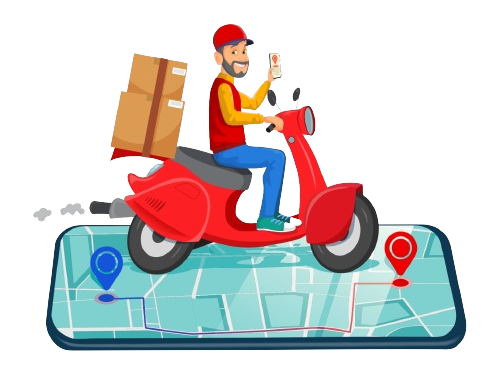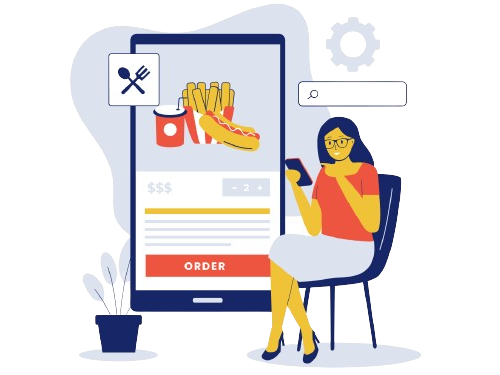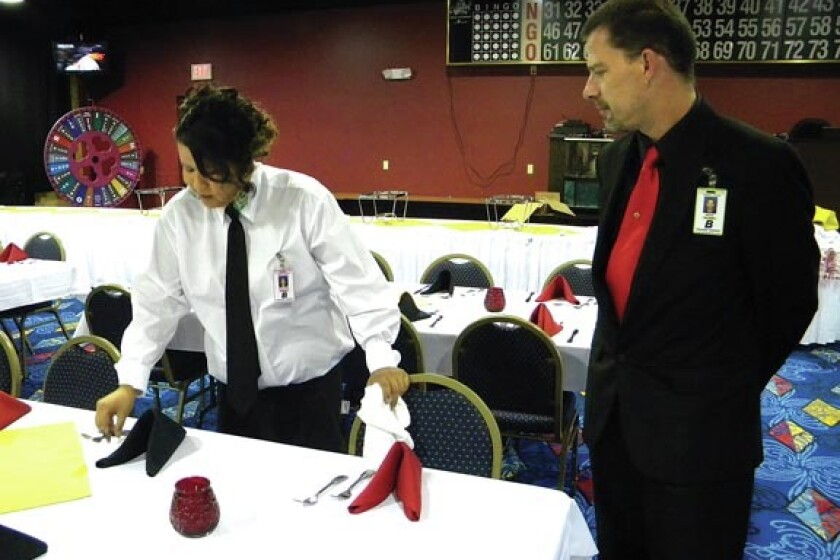Are you inspired by on-demand food delivery apps that are booming these days? Or you just feel like there is something lagging in the food delivery app market and can’t figure out the missing piece of the puzzle?
Food delivery apps are ever-evolving, particularly post-pandemic has given them a noticeable surge and they also yield substantially high ROI. Developing a food delivery seems like a thrilling adventure but executing the idea is no piece of cake.
Don’t worry as we’ve got you covered. We will let you know great tips and tricks to compete with your rivalries and surpass them with your app’s success. Let’s dive deep into our step-by-step food delivery app development guide.
What is a Food Delivery App & How It Works?
A food delivery app serves as a middleman between patrons and eateries / restaurants.
The first step begins with you, craving for something delicious. Many well-known eateries and large food chains have their own delivery apps, although they are limited to particular locations. It is acceptable if you are certain of what you want and where to get it, don’t you think it’s more fun to have a wide variety of restaurant options?
Grand View Research suggests that increased smartphone usage and better network connectivity could be factors in the meal delivery industry’s explosive rise. By 2030, it’s expected that the global market for online food delivery will generate $505.5 billion in sales. Additionally, it appears like the ideal moment to design your own mobile app.
Key Features of a Food Delivery App
Relevant features are essential for a food delivery software to ensure rapid business growth and outstanding user experience. Here some of the important features are explained for a good food delivery application:

- Profile Registration & Management:
The platform should simplify it to deal with delivery staff, restaurants, and clients. Arriving at this goal can be helped with a particular dashboard.
- Offers/Deals Management:
The two major benefits of this tool are increasing commitment and keeping in touch with your clients. You can elucidate your clients about deals, offers, loyalty programs, etc
- Geo-Fencing:
This element allows the admin to assign the locale they wish to support. Assuming they are offering types of assistance in a specific region, they can concentrate on the socioeconomics of that local area and change the manner in which they market and deal with their administrations.
- Restaurant Management:
The platform’s executive is answerable for directing a few restaurants that are recorded. This admin can easily and undoubtedly add or remove restaurants.
1. Restaurant App
Provision of discounts, deals, and offers to your customers may help you increase customer retention and engagement. It is a great technique for producing income and drawing in new clients to your foundation.
- Order and menu management must be incorporated in your food delivery app. Restaurants can just oversee requests and update their menus with a single click thanks to particular dashboards. Furthermore, it works on each part of restaurant tasks.
- Diners can get instant updates and notifications for orders and other vital data.restaurants may just monitor the delivery faculty and the request’s status utilizing constant monitoring.
2. Customers’ App
- Allow customers to use a search bar for different filters for their needs. Using targeted keywords, customers may quickly and simply find their favorite restaurants and cuisines using the search filter, saving them from having to browse the entire app.
- Different installment choices should be given to clients to work with expedient and basic exchanges. You could choose to utilize notable installment APIs like Stripe, PayPal, and different decisions like internet banking, eWallets, and so forth. Besides, it is significant to ensure the security of the installment cycle.
- Real-time order tracking facility educates customers regarding the whereabouts of their order and when their orders are supposed to be delivered.
- Adding a feature of reviews and ratings. App users can leave reviews and ratings about the food and restaurants they visit.
3. Delivery Personnel / Courier App
- The platform’s easy registration process enables delivery personnel to quickly register, personalize their profile, and start receiving and delivering orders. Nonetheless, the administrators are able to finish the verification.
- Delivery staff may conveniently handle and review their order requests with the help of this feature. This way, delivery staff will be better at organizing and managing several orders.
- Delivery staff can work all the more beneficially with the guide of GPS following and route streamlining. With live route streaming, they can convey more requests in a limited time.
- Including a feature of status update or messenger within the app, delivery person can tell you if an order is completed and on its way to being delivered, is in progress, or is delayed.
How to Develop a Food Delivery App in 5 Simple Steps?
Time to answer the main question: how to develop a food delivery app?
Well, building an on-demand food delivery app involves a systematic approach. Let’s find out whats and hows of the process.
1. Begin with Market Research
Before plunging into the development process, it is essential that you’re aware of the possibilities and current trends in the on-demand food delivery industry. Performing statistical surveying will introduce opportunities for extension and uniqueness. Examine your targeted group, any holes in the current market, distinguish your rivals’ assets, shortcomings and application functionalities, and afterward plan out a procedure. Making an application with the legitimate highlights and functionalities requires understanding about what the objective client base needs from another participant on the lookout.Choose Your Business Model & Strategy
Establish a business plan for your food delivery service that works with your app. Choose how you will partner with service providers. They are primarily three models to go about it:
- Aggregator: collaborating with different restaurants, as an intermediary and offer a wide range of options
- Logistics-focused approach: In this model, the food delivery app supplies its own delivery fleet in addition to aggregating restaurants.It directs the entire delivery process, making it workable for restaurants without delivery faculty to finish orders
- Own delivery Model or white label solution: A specific application for your own restaurant.
2. Cherry-Pick Your App Features
Figuring out which features are generally more necessary to both users and restaurants is the most vital step towards spurring an astounding on-demand food delivery service. These functions include, for instance:
- User-friendly interfaces
- Real-time order tracking
- Secure payment methods
- Personalized profiles of uses
- Reviews and ratings
- Loyalty schemes
- Customized food tastes

3. Design & Develop Your Food Delivery App
The final step is to go about designing and building your app. Meticulously-designed user interfaces for all the roles of the application (Business, courier, admin panel and customer) are important to ensure a flawless app design.
Create wireframes and prototypes to ensure your food delivery app is fully-functional as per your business needs.
4. Testing your Food Delivery App
Conduct rigorous testing to identify, and resolve issues at each development stage, but particularly do it once you’re done with the final stage of development. Perform rigorous testing of:
- App performance
- Scalability testing
- Interoperability with many devices
- OS optimization
It keeps the software running smoothly for everyone.
5. Plan for Marketing & App Promotion
Your on-demand food delivery app needs a solid marketing plan to attract customers. Create a strong marketing plan by using different social media platforms, influencers’ marketing, content marketing and app store optimization (ASO).
Cost of Developing a Food Delivery App
Cost is a critical consideration for any type of business, including startups. Make sure that it fits inside your budget.
The complexity of the app, maintenance needs, platform, software, and technology requirements, the food delivery app model, and the development team you will be hiring are just a few of the factors that make it difficult to pinpoint the exact cost of food delivery apps.
The development of a meal delivery app can cost anything from $80,000 to $100,000. However, this can change much more based on the previously listed variables. Thus, it’s critical to select the best company that meets your financial needs.
Conclusion
Food delivery apps have gained huge traction post-Covid. Online food ordering has become more popular than dining out. Your app’s success depends on how well you define its features and functionalities, choose the right technology stack, and prioritize design and UX. User and restaurant dashboards, payment gateway integration, and tracking and delivery should be developed separately. A reliable and well-polished app requires significant quality assurance and testing.
Let Stackup Solutions help you in building your dream food delivery app. We envision your idea as our brainchild and transform it into a reality. Hit us up and find out what we can do for you!!
FAQs (Frequently Asked Questions)
1. How to develop a food delivery app?
Food delivery apps can be developed mainly in two ways. Starting from scratch and hiring a group of engineers and designers is one alternative, but this would need a lot of time, financial, and resource commitments. Or the other option is to consider employing a ready-made software solution; it’s less expensive, saves time, and works well.
2. What are the most crucial factors of the app’s design for a food delivery app?
User-friendly interfaces, real-time order tracking, secure payment methods, personalized profiles of uses, reviews and ratings, loyalty schemes, meal customization options and smooth login processes are the most crucial factors for your food delivery app.
3. Is there a list of typical problems encountered by app developers, and suggestions for fixing them?
Technical complexity, assuring cross-platform compatibility, satisfying user expectations, maximizing app speed, and keeping up with developing technology are just some most common challenges encountered during app development. Working with professional app developers, performing extensive testing, collecting user feedback, and continuously iterating and improving your app in response to user needs and market trends will help you overcome these obstacles.




.jpeg)